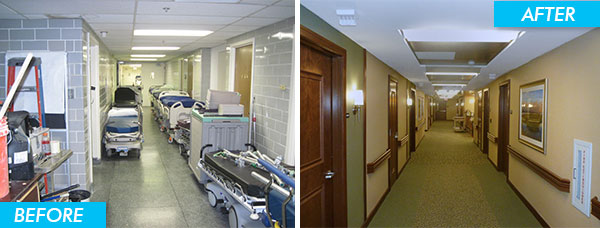As hospitals evolve, service lines expand and contract, new technologies are embraced, building codes change, and new state-of-the-art specialty centers are needed. Existing hospital spaces must be repurposed to meet these ever-changing needs. Among the challenges in repurposing older hospital facilities is working with physical constraints such as small space floor plates and low floor to floor heights. However, these challenges can be overcome with thorough analysis and creativity. A recent example of a successful transformation of old hospital space is the new Community Hospice Center for Caring at St. Vincent's Medical Center Riverside in Jacksonville, Florida.
Community Hospice of Northeast Florida requested a 10-bed inpatient hospice unit. St. Vincent’s Medical Center Riverside offered 6,700 square-feet of space on the 4th floor of an old 1920’s hospital that had been in most recent history serving as a bed repair shop for the hospital (it originally served as the labor & delivery unit).
The goal was to take this outdated space and create a space that would meet the needs of patients receiving end-of-life care by creating a place that felt more home-like than institutional, and more hospitality-like in nature than a typical medical/surgical nursing unit. Having worked previously with Community Hospice to design the new Bailey Family Center for Caring at Flagler Hospital in St. Augustine, Florida, GS&P’s designers had a good understanding of the appropriate look and feel the repurposed space at St. Vincent’s needed to be.
Let’s look at some images that showcase the before and after.
These three floor plans show the evolution of this same space within the hospital from its original construction through a renovation in the 1970s and now the current layout of a 10-bed hospice unit. You can see where a new corridor was reconfigured to maximize the size of each patient room. The layout of nursing station, support spaces, and staff lounge were planned to promote convenience and to minimize staff travel distances for Community Hospice staff.
The before image above shows the corridor while the space served as a bed repair shop. The after image shows how we have replaced a more institutional terrazzo flooring with a more home-like carpet. This impacts not only the overall look and feel, but also helps to mitigate noise in the hallway so it is less of a disturbance to patients and their families. Sterile wall details have been swapped for a more soothing color palate, wall protection, and artwork depicting nature. Doorways and handrails were specified with wood finishes that supports and gives a more home-like feel.
Over the years, several windows in the unit had been bricked in. In order to bring more light into the new patient rooms, the team cut and reinserted windows so that patients and staff had access to daylight. Each of the patient rooms has a ceiling fan and the ceilings are designed with hard gypsum board that you would see at home as opposed to a more typical ceiling tile grid. Knowing the importance of family presence and its relation to patient satisfaction, we also created a designated family room as a place for them to be close within the unit without having to always be in the patient room as well as a quiet room for family privacy and reflection. There is also a laundry room provided with washer/ dryer for family to use if they have been visiting family for extended periods of time.
This before and after of the nurse station details how the home-like feel was translated to this space as well. The nurse station was located centrally right at the T-intersection of the corridor, both to help with staff access to patients and to help with overall security within the unit.
Updating this space has allowed Community Hospice to expand their reach of services provided within the Jacksonville area. Its design complements the standard they are striving to provide their patients and families receiving end of life care. But what has been really rewarding to us is how this overall renovation has in some ways mimicked the overall circle of life theme this unit represents, whereby the space was transformed from a place where babies were born to a place where adults pass on with the comfort of their families. Seeing how this space has evolved and been repurposed since its initial inception, and this new life that has been breathed into it, has been special to be a part of.
Written by Christopher Coombs. Joseph C. Bucci, AIA, NCARB, contributed to the development of this post.
More from Author
Gresham Smith | Oct 16, 2024
How AI can augment the design visualization process
Blog author Tim Beecken, AIA, uses the design of an airport as a case-study for AI’s potential in design visualizations.
Gresham Smith | Aug 17, 2023
How to design for adaptive reuse: Don’t reinvent the wheel
Gresham Smith demonstrates the opportunities of adaptive reuse, specifically reusing empty big-box retail and malls, many of which sit unused or underutilized across the country.
Gresham Smith | May 24, 2023
Designing spaces that promote enrollment
Alyson Mandeville, Higher Education Practice Leader, argues that colleges and universities need to shift their business model—with the help of designers.
Gresham Smith | Apr 24, 2023
Smart savings: Commissioning for the hybrid workplace
Joe Crowe, Senior Mechanical Engineer, Gresham Smith, shares smart savings tips for facility managers and building owners of hybrid workplaces.
Gresham Smith | Mar 20, 2023
3 ways prefabrication doubles as a sustainability strategy
Corie Baker, AIA, shares three modular Gresham Smith projects that found sustainability benefits from the use of prefabrication.
Gresham Smith | Jan 19, 2023
Maximizing access for everyone: A closer look at universal design in healthcare facilities
Maria Sanchez, Interior Designer at Gresham Smith, shares how universal design bolsters empathy and equity in healthcare facilities.
Gresham Smith | Dec 20, 2022
Designing for a first-in-the-world proton therapy cancer treatment system
Gresham Smith begins designing four proton therapy vaults for a Flint, Mich., medical center.
Gresham Smith | Nov 21, 2022
An inside look at the airport industry's plan to develop a digital twin guidebook
Zoë Fisher, AIA explores how design strategies are changing the way we deliver and design projects in the post-pandemic world.
Gresham Smith | Feb 13, 2022
Helping maximize project dollars: Utility coordination 101
In this post, I take a look at the utility coordination services our Transportation group offers to our clients in an attempt to minimize delays and avoid unforeseen costs.
Gresham Smith | May 7, 2021
Private practice: Designing healthcare spaces that promote patient privacy
If a facility violates HIPAA rules, the penalty can be costly to both their reputation and wallet, with fines up to $250,000 depending on the severity.




















